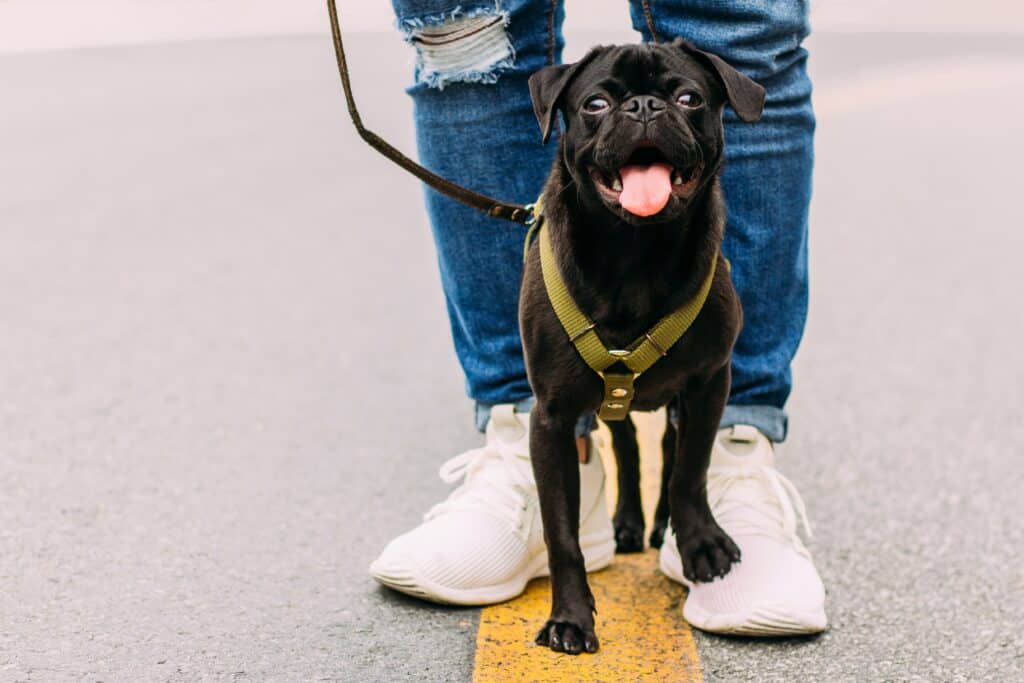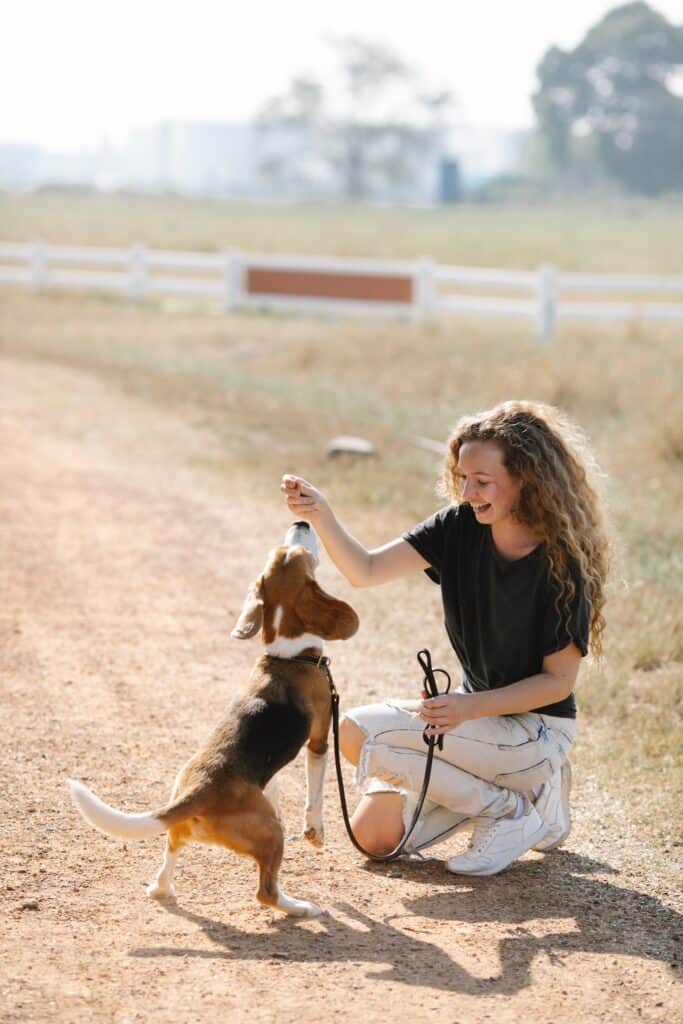How To Train A Puppy to Walk On a leash
- It is not as difficult as you might assume to teach a puppy to walk on a leash.
- If your dog misbehaves on leash, there are uncomplicated remedies available that do not involve pulling or dragging.
- Prior to venturing outside, ensure that your young canine is outfitted with a collar and leash and has worn them indoors.
Many people mistakenly believe that dogs have a natural talent for walking calmly on a leash. However, this is not the case. This is a capability that necessitates practice. Learning how to walk nicely on a leash is a crucial ability that you will value each time you take your pet for a walk.
Teach A Puppy leash rules
Training A Puppy Or Dog leash training
Begin the process of acquainting the puppy with the collar or harness and leash: Allow him to gradually become comfortable with the experience of wearing a collar or harness and being on a leash. Initially, permit him to wear them for brief intervals inside the house while engaging in playtime and rewarding him with treats. The puppy should develop a fondness for wearing the collar and leash as it signifies nourishment and enjoyment.
Introduce a sound cue to your puppy that signifies the arrival of food: The method for doing this is consistent regardless of whether you prefer to click and treat, use a word like “yes,” or cluck your tongue. In a quiet and distraction-free environment, with your puppy on a collar and leash, produce the sound. As soon as your puppy turns in your direction and/or makes eye contact with you, reward them with a treat. You will notice your puppy not only paying attention to you, but also approaching you for the treat after a few repetitions.
Teach your puppy to come to you: by calling him while he’s still wearing his leash and collar. As he moves towards you, take a few steps back and reward him when he reaches you. Keep practicing this exercise until your puppy comes to you upon hearing the cue noise and walks beside you for a few steps. Remember to keep your training sessions brief, as puppies have a limited attention span. Always stop the session while your puppy is still eager to learn more, rather than when he is mentally fatigued.
Practicing indoors with minimal distractions: Walking just a few steps with the leash on will be a sufficient challenge for your puppy. Remember to reward your puppy with treats and praise as they become more comfortable with coming to you while wearing the leash, as previously described.
Moving outdoors: is the next step. Now that your pup has been trained, it’s time to put their skills to the test outside. It’s important to note that this step comes with new obstacles as your pup will encounter new and fascinating sights, sounds, and odours. It’s crucial to remain patient and keep the initial walks brief. When out on a stroll, observe your pup closely and issue your cue sound and step away if they seem to be about to lunge or become distracted. Once they follow you, offer them a treat as a reward.

goal is to walk on a loose leash
Hold the leash in your hand while your dog sits on the same side. Keep tasty treats hidden in your other hand. Ensure that the leash is loose enough to remain slack if your dog walks slightly ahead or beside you. Use a cheerful voice to say “Let’s go!” and begin walking. Once your dog starts walking alongside you, say “Yes!” (or use a clicker) and give a small, tasty treat near your knee. Initially, say “Yes!” and reward frequently, almost with each step. Gradually decrease the frequency of saying “Yes!” and giving treats as your dog pays more attention to you.
As your dog becomes proficient in this activity, slowly reduce the rate of saying “Yes!” and giving treats. Make sure to say “Yes!” and reward randomly, such as on the fourth step, second step, tenth step, and so on. This prevents your dog from anticipating a reward every tenth step and losing focus during the other steps. Be cautious not to reduce the reward rate too quickly, as it may frustrate your dog and cause them to stop exhibiting the desired behaviour. Additionally, avoid pulling on the leash, as this can make your dog anxious and lead to pulling behaviour.
Troubleshooting leash-training issues.
As your puppy grows older and explores new environments, it’s inevitable that you will encounter challenges even if he’s already making progress on leash training. It’s highly recommended to train your canine friend on walking with a loose leash, as it will create a more enjoyable experience for both yourself and your furry companion.
In cases where your dog pulls on the leash during walks it is recommended that you stop and stand still, becoming motionless like a tree until your dog returns to your side. It is advised that you refrain from forcefully tugging or yanking on the leash, or dragging your dog behind you. Instead, consider using front-hook harnesses and head halters as training tools for dogs that have a tendency to pull.
If your dog attempts to go after something while on a walk such as another dog, a car, or a skateboarder, take action beforehand. Attempt to divert your dog’s attention with a treat before he gets the chance to lunge, and increase the distance between your dog and the object of his interest. Stay alert and ready before the object becomes too close to your dog’s range of frustration. This kind of behaviour may be more prevalent in herding breeds, but any dog can be caught off guard by something new or stimulating.
Dogs may bark at other dogs while on a walk, which can be caused by inadequate exercise. Providing your dog with appropriate physical and mental stimulation for their age and breed is essential. If barking persists, you can use the same method as mentioned earlier for lunging. This involves creating distance and giving treats before your dog starts to bark. The goal is for your dog to become accustomed to looking at you instead of barking when they see another dog.
Over time, you will decrease the frequency of treats and assistance required during your puppy’s walks. However, it is recommended to have a supply of treats readily available to occasionally reward your pup for exhibiting good leash-walking behaviour.
how long does it take to leash train a puppy?
Puppies are highly trainable and can likely become proficient on a leash within a month. However, it is important to be cautious of the transitional phase that dogs experience around nine months of age, often referred to as the “teenage” phase. During this period, dogs may act as if they have forgotten all they have learned. It is important to be prepared to reiterate training and address any boundary-testing behaviours.
FAQ
How to leash train a puppy that won’t walk ?
Familiarize the puppy let them smell and explore the walking gear.
Adjust Collar Position doesn’t allow the pup to get use to a certain feeling of resistance.
Shorten the Leash forces the pup to follow when you move.
Check the Feet it may have some debris or a foreign object that restricting movement.
Use Verbal Commands dogs use their ears as communication certain commands like “let’s go” will encourage forward movement.
Stay Still if the puppy pulls until it relaxes then reward !
Pick Up the Pace if your puppy get distracted easily, they will have less time to discover new things.
More Frequently walks will keep the dogs leash rules refreshed and practiced
Use treats to reward your puppy good leash behaviour as this will reinforce the good decisions.
Is there a special leash for training a dog to walk?
It is advisable to utilize a training leash that measures 2 meters in length and is fastened to a harness. This will provide your puppy with sufficient liberty to learn, while remaining manageable. You will have the capability to prevent them from approaching traffic effortlessly.
What age should you start leash training a puppy?
Puppies can acquire basic commands, such as leash training, as early as eight weeks old. Once you have welcomed your puppy into your home and commenced their training, it is appropriate to introduce a leash and harness.

